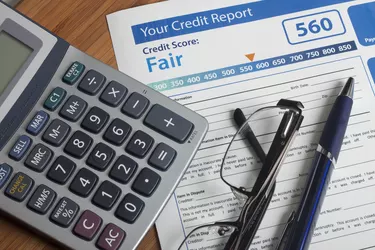
- Copy of your credit report
Warning
Keep your credit reports in a safe place. Most of them contain identifying information that could be used for fraud or identity theft.
Video of the Day
Tip
Save your credit reports so you have an accurate view of your total credit history. This will help you spot changes and errors from one year to the next.
It's a good idea to get a copy of your credit report from each reporting agency once per year. This will give you valuable information on who has been accessing your report and why, whether there are errors on your report that negatively affect your credit score, and whether or not you are a victim of credit fraud. However, once you've received a copy of your credit report, it can be hard to figure out what all of those codes mean. Learn how to decipher what credit reporting agencies are saying about you.
Video of the Day
Step 1
Visit the Annual Credit Report website to get a copy of your free credit report (see Resources section). Everyone in the U.S. is allowed one free copy of their credit report per year from each of the three major credit reporting agencies. You can have the reports mailed to you or print them from your computer.
Step 2
View the Trans Union Payment History section. This is where the mysterious codes reside. These usually appear on the right hand side of the document under your credit accounts and shows your payments for a period of time relating to each account. For example, if you recently opened a credit card account, you may only see the code "0" which means that there is no balance or you may see an "X" which means that nothing was reported that month because it is so new. A "1" means the account is current and every number after that denotes a 30-day late payment, in increments of 30 days. So, if "1" is current, a "2" is 30 days late and a "3" is 60 days late. This continues up to "7" which means 180 days late. After that you receive a code "9" which means the account has gone to collections. If you see a code "B" this means there was a payment change and no other code is applicable. Each of the reporting companies uses a different code series.
Step 3
View the Trades section on your Experian report. Under this section you will see codes relating to loans and bank cards with a credit history. The codes for this area are: CURR ACCT = Account is current and in good standing CUR WAS 30-2 = Account is current, was 30 days late twice PAID = Account has been paid off to a zero balance and is inactive CHARGOFF = Unpaid balance has been included as loss by credit grantor and they are no longer seeking reimbursement COLLECT = Account is seriously past due and has been assigned to collections FORECLOS = Property was forclosed BKLIQREQ = Debt forgiven through Chapter 7, 11 or 13 DELINQ 60 = Account is 60 days past due INACTIVE = Account is inactive CLOSED = Account is closed
Step 4
Review your Experian Payment History. Similar to the Trans Union codes, Experian's vary only slightly. C, N or 0 mean your account is current without a balance. 1-6 is 30-180 days past due and 7, 8 or 9 means bankruptcy has been filed or that the house is currently in foreclosure proceedings. You might also see: G = Collection H = Foreclosure J = Voluntary surrender K = Repossession L = Charge off B = Account condition changed, payment code not applicable - = No payment history that month
Step 5
Review your Equifax Payment History. Equifax's codes include: * = Current N = Current account/zero balance-no update tape received 0 = Current account/zero balance-reported on update tape 1 = 30 days past the due date 2 = 60 days past the due date 3 = 90 days past the due date 4 = 120 days past the due date 5 = 150 days past the due date 6 = 180 days past the due date 7 = Bankruptcy Chapter 13 (Petitioned, Discharged, Reaffirmation of Debt Rescinded) 8 = Derogatory, e.g. foreclosure proceeding, deed in lieu 9 = Bankruptcy Chapter 7, 11, or 12 (Petitioned, Discharged, Reaffirmation of Debt Rescinded) G = Collection H = Foreclosure J = Voluntary surrender K = Repossession L = Charge off B = Account condition change, payment code not applicable - = No history reported for that month